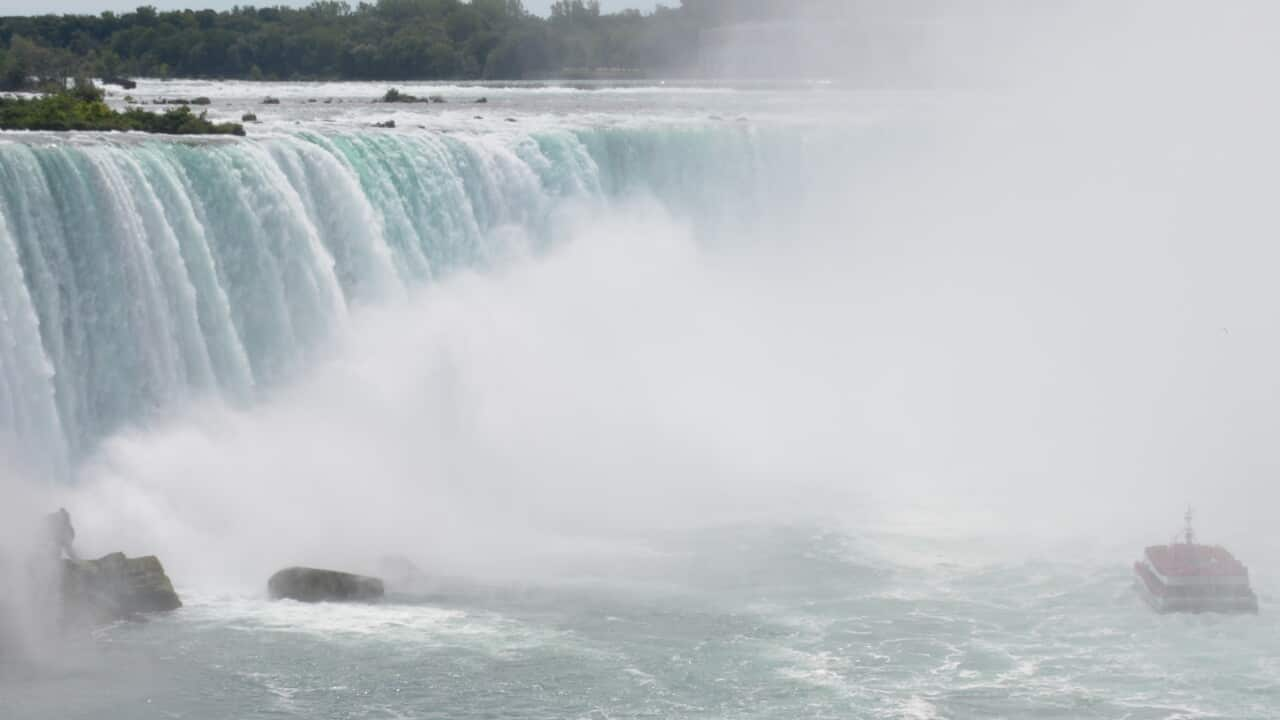Niagara Falls is composed of three extraordinary falls including: Horseshoe Falls on the Canadian side and American Falls and Bridal Veil Falls on the American side.
The Horseshoe Falls are 2,600 feet ( 792 m) wide with the American Falls measuring 1,060 feet (323 m) wide. The highest drop occurs on Horseshoe Falls at 173 feet (53 m).
Niagara Falls has an average of estimated 4 million cubic feet (110,000 cubic meters) of water every minute with heavy flow reaching as much as 6 million cubic feet (168,000 cubic meters) every minute. Horseshoe Falls accounts for approximately 90% of the water volume.
Located on the Niagara River, which drains Lake Erie into Lake Ontario, the combined falls form the highest flow rate of any waterfall in the world that has a vertical drop of more than 165 feet (50 m). Horseshoe Falls is the most powerful waterfall in North America, as measured by vertical height and flow rate.
The Niagara Falls are well-known both for their beauty and as a treasured source of hydroelectric power. Balancing recreational, commercial, and industrial uses has been a challenge for the stewards of the falls since the 19th century.
The volume of water approaching the falls during peak flow season may sometimes be as much as 225,000 cubic feet (6,400 m3) per second. The average annual flow rate is 85,000 cubic feet (2,400 m3) per second.
The flourishing green colour of the water flowing over the Niagara Falls is a by product of the estimated 60 tonnes/minute of dissolved salts and "rock flour" (very finely ground rock) generated by the erosive force of the Niagara River itself.
The Niagara Falls of today were created by the Wisconsin glaciation about 10,000 years ago. The same forces also created the North American Great Lakes and the Niagara River.
There are contradicting theories as to the origin of the name of the falls. According to Iroquoian scholar Bruce Trigger, "Niagara" is derived from the name given to a branch of the local native Neutral Confederacy, who are described as being called the "Niagagarega" people on several late-17th-century French maps of the area. According to George R. Stewart, it comes from the name of an Iroquois town called "Ongniaahra", meaning "point of land cut in two".
During the 19th century, tourism became popular, and by mid-century, it was the area's main industry.
After the American Civil War, the New York Central Railroad publicised Niagara Falls as a focus of pleasure and honeymoon visits. With increased railroad traffic, in 1886, wood and stone bridge was replaced with the predominantly steel bridge that still carries trains over the Niagara River today.
In 1941 the Niagara Falls Bridge Commission completed the third current crossing in the immediate area of Niagara Falls with the Rainbow Bridge, carrying both pedestrian and vehicular traffic between the two countries and Canadian and U.S. customs for each country.
After the First World War, tourism boomed again as transportation made getting to the falls much easier. The story of Niagara Falls in the 20th century is largely that of efforts to harness the energy of the falls for hydroelectric power, and to control the progress on both sides that threaten the area's natural wonder.
There are earlier accounts of people going over the falls in a barrel as a publicity stunt; some survived, unharmed, but others have drowned or been severely injured. Survivors faced charges and stiff fines, as it is illegal, on both sides of the border, to attempt to go over the falls.
Other daredevils have made crossing the gorge their goal. Between 1859 and 1896 a wire-walking craze emerged, resulting in frequent feats over the river below the falls. One inexperienced walker slid down his safety rope. Only one man fell to his death, at night and under mysterious circumstances, at the anchoring place for his wire.
These tightrope walkers drew huge crowds to witness their exploits. Their wires ran across the gorge, near the current Rainbow Bridge, not over the waterfall itself. Tightrope crossings of the falls ended by virtue of law in 1896.
Niagara Falls is a huge tourist attraction. Summertime is a peak season for visitors, when Niagara Falls are both a daytime and evening attraction. From the Canadian side, floodlights illuminate both sides of the falls for several hours after dark (until midnight). The attendance figure for 2013 was 8.86 million, with the peak summer months of June, July and August posting in excess of 1.8 million visitors each month. An annual attendance figure of eight million suggests 606,000 people per month, or about 21,000 people per day, visit Niagara Falls State Park and related attractions on an annual basis.
The oldest and best known tourist attraction at Niagara Falls is the Maid of the Mist boat cruise, named for an ancient Ongiara Indian mythical character, which has carried passengers into the rapids immediately below the falls since 1846. Cruise boats operate from boat docks on both sides of the falls.
Niagara Falls is indeed one of the great natural wonders of the world! Putting it in one’s bucket list is a real MUST!
Share
